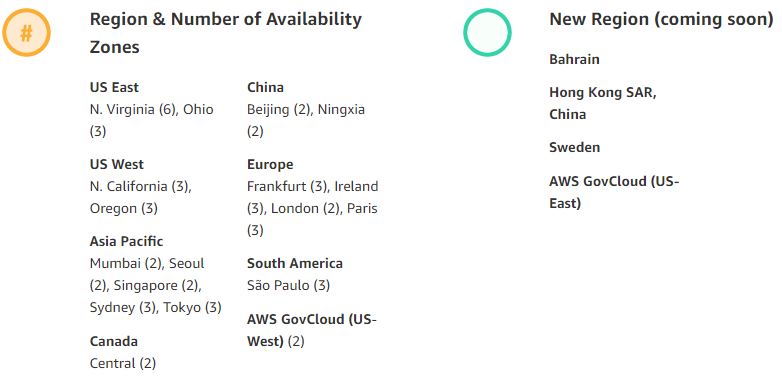References - A Cloud Guru, AWS Documentation
AWS Global Infrastructure
Region - AWS Region is a place in the world where AWS resources exist. Region is a geographical area.
Availability Zones - Availability zone is a data center or it could be a collection of data centers. Each reason consists of 2 or more Availability Zones. In a region, each AZ is isolated and spaced away from another AZ. This achieves the greatest possible fault tolerance and stability. E.g. If there is flood in Manhattan affecting the AZ in Manhattan, then the AZ in New Jersey won't be impacted.
Each reason consists of 2 or more Availability Zones. In a region, each AZ is isolated and spaced away from another AZ. This achieves the greatest possible fault tolerance and stability. E.g. If there is flood in Manhattan affecting the AZ in Manhattan, then the AZ in New Jersey won't be impacted.
AZs are connected to each other via low latency links. (Low latency = Low delay)

All communication between regions is across the public Internet. Therefore, appropriate encryption methods should be used to protect your data. Data transfer between regions is charged at the Internet data transfer rate for both the sending and the receiving instance.
When you view your resources, you'll only see the resources tied to the region you've specified. This is because regions are isolated from each other, and we don't replicate resources across regions automatically.
Below image lists the 18 regions and 49 Available Zones as of 7th Jan 2018. Not all the regions are accessible from the Global AWS account. For example, China and AWS GovCloud regions cannot be accessed from global AWS account due to regional and compliance issues. Separate URLs, credentials and endpoints are available for China and GovCloud regions.
So, you can effectively utilize 15 regions and 43 Availability zones from AWS global account.

The AWS Cloud has announced plans to expand with 12 new Availability Zones in four new geographic Regions: Bahrain, Hong Kong SAR, Sweden, and a second AWS GovCloud Region in the US.
Also, not all the services are available in all the regions. This link keeps an up-to-date copy of available services in each region.
Edge Locations - They are CDN endpoints for AWS CloudFront. Its a way to cache very large media objects in the cloud. Edge Locations are located in most of the major cities in the world.
If a user in NY wants to download the video currently located in Australia, then for the first time, the video will need to travel all the way from Australia to NY and it will be cached. Next time, when somebody tries to download the video again, it will be served from an Edge location.
There are many more edge locations than there are regions.
How Region and Availability Zones Helps?
High Availability Through Multiple Availability Zones
Unlike virtually every other technology infrastructure provider, each AWS Region has multiple Availability Zones and data centers. Customers who care about the availability and performance of their applications want to deploy these applications across multiple Availability Zones in the same region for fault tolerance and low latency. Availability Zones are connected to each other with fast, private fiber-optic networking, enabling customers to easily architect applications that automatically fail-over between Availability Zones without interruption in case an AZ goes down.
Improving Continuity With Replication Between Regions
In addition to replicating applications and data across multiple data centers in the same Region using Availability Zones, customers can also choose to increase redundancy and fault tolerance further by replicating data between geographic Regions. They can do so using both private, high speed networking and public internet connections to provide an additional layer of business continuity, or to provide low latency access across the globe.
Meeting Compliance and Data Residency Requirements
Customers retain complete control and ownership over the region in which their data is physically located, making it easy to meet regional compliance and data residency requirements. E.g. Financial instutions want to keep their data in the country where they operate or their HQ is located.